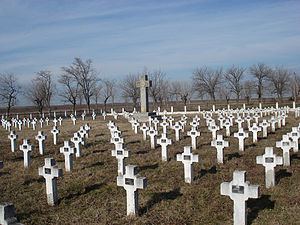5,000 ? Date 28 November 1916 | 4,866 ? | |
 | ||
Combatants Kingdom of Romania, Kingdom of Bulgaria Results Central Powers tactical victory, Successful Romanian delaying action Similar World War I, Battle of Bucharest, Flămânda Offensive, Battle of the Argeș, Second Battle of Oituz | ||
The Prunaru Charge (Romanian: Şarja de la Prunaru) was one of the most daring actions of the Romanian Armed Forces in World War I. The cavalry charge took place on November 28 [O.S. November 15] 1916 in Prunaru (today part of Bujoreni commune, Teleorman County), and was a component operation of the Battle of Bucharest.
Contents
Background and course
After the Danube was breached by German, Bulgarian and Ottoman troops under the command of General August von Mackensen, and after German-Austro-Hungarian forces under the command of General Erich von Falkenhayn crossed the Carpathians, the Central Powers planned to trap and annihilate the Romanian forces between these two natural barriers and, by implication, remove Romania from the war. In the autumn of 1916, the most complex operation of the Romanian Fourth Army, under the command of General Constantin Prezan, took place in the Argeş–Neajlov sector, in what has come to be known as the Battle of Bucharest.
On November 14/27, the Kosch Group (217th German infantry division, 26th Turkish infantry division and the von der Goltz cavalry division), led by Robert Kosch, vigorously advanced along the Zimnicea–Drăgănești-Vlașca–Bucharest line, while a secondary group (1st and 12th Bulgarian infantry division) advanced along the Zimnicea–Giurgiu line, occupying the latter city that evening. On the main line, the attack was stopped by the 18th Romanian infantry division along the line formed by the Teleorman River valley. Intending to continue the defence of the division, an Alpenkorps battalion from the vanguard of the 217th German infantry division occupied the village of Prunaru on the afternoon of November 14/27. In order to avoid being encircled and the forces having to retreat to a new position, General Alexandru Referandru, commander of the 18th infantry division, decided to attack the enemy in the vicinity of Drăgăneşti-Vlaşca, using the 43rd mixed brigade and the 2nd Roşiori cavalry regiment.
On the morning of November 15/28, unusually fierce fighting took place at the edge of Prunaru involving the vanguard of the 43rd mixed brigade and the occupying forces. The fog lifted, and taking advantage of this, the Germans began a manoeuvre to surround the 43rd brigade using units situated outside the village. At that moment, General Referandru ordered the 2nd Roşiori regiment to enter the battle. Thus began the Prunaru Charge. Constantin Kiriţescu described it as follows: "Behind fences, in brambles, in the windows of the houses and on the bridges, the enemy hid tens of machine-guns, and threw a hail of bullets onto the mighty regiment. Horses and horsemen fell in a jumble over each other. Two hundred people remain on the field of battle, forming, together with the horses' cadavers, masses of bleeding flesh. Among them, all the officers of the regiment, starting with their brave commander".
Aftermath
The 2nd Roşiori cavalry regiment perished almost in full (just 134 of 5,000 survived), but due to its actions at Prunaru, the 18th Romanian infantry division was able to regroup along the Letca Veche–Jilava line and contribute in full to the defensive operations for Bucharest.
